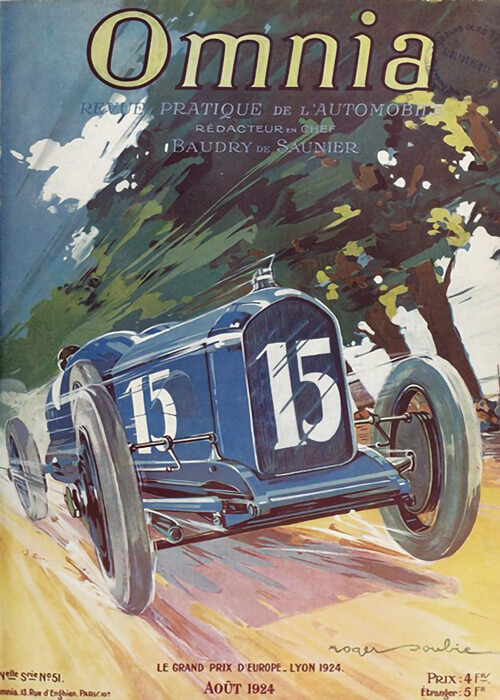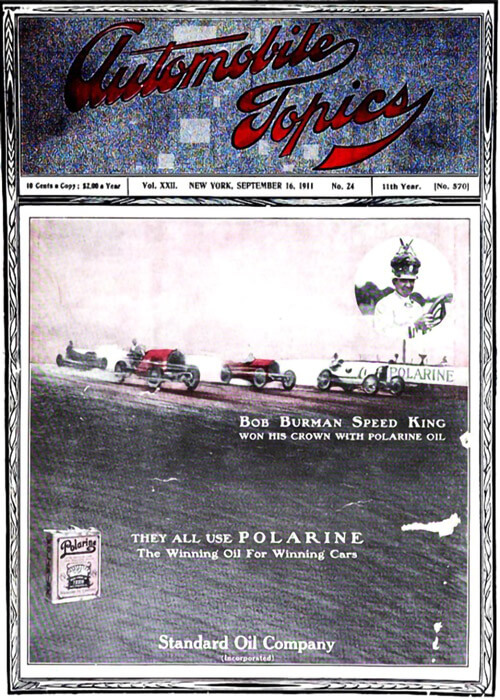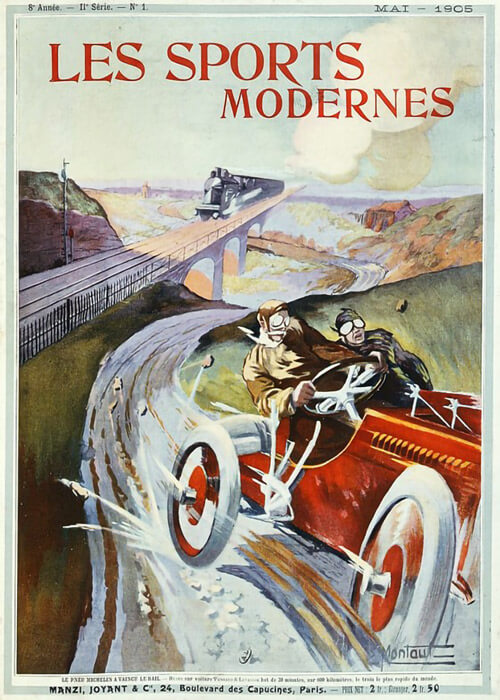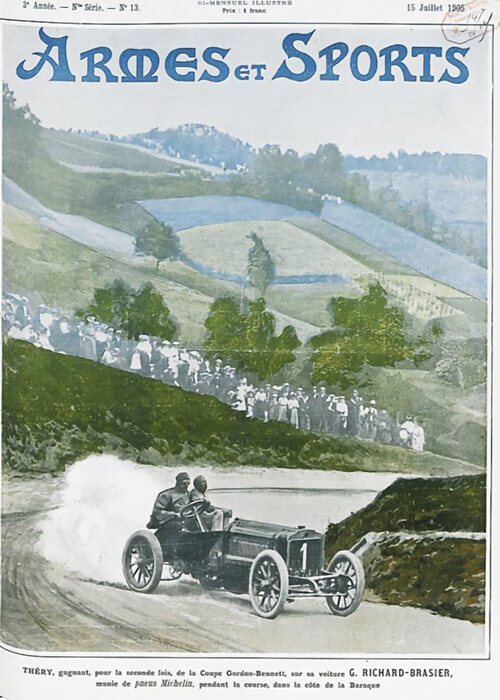The 1912 Grand Prix de l’ACF was held over two days in June at the triangular circuit of Dieppe near the North Sea coast. Georges Boillot in the new Peugeot L76 won the race. It marks the first of so many tace wins of the car with the novel engine that was to become the hallmark of racing engines for a long time after. It was characterized by a hemispherical combustion chamber, four valves per cylinder and twin overhead camshafts; designed and developed by the so-called Charlatans of the Peugeot development department. The American driver David Bruce-Brown, however, also starred in this race, although he did not finish. Tree Sunbeams finished on 3rd, 4th and 5th place.




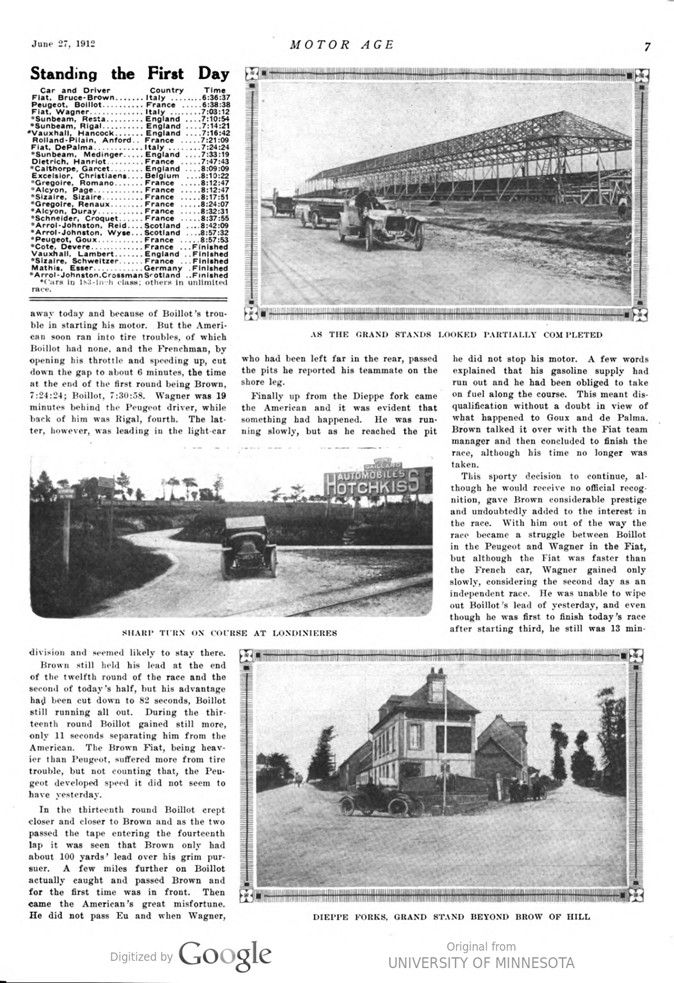
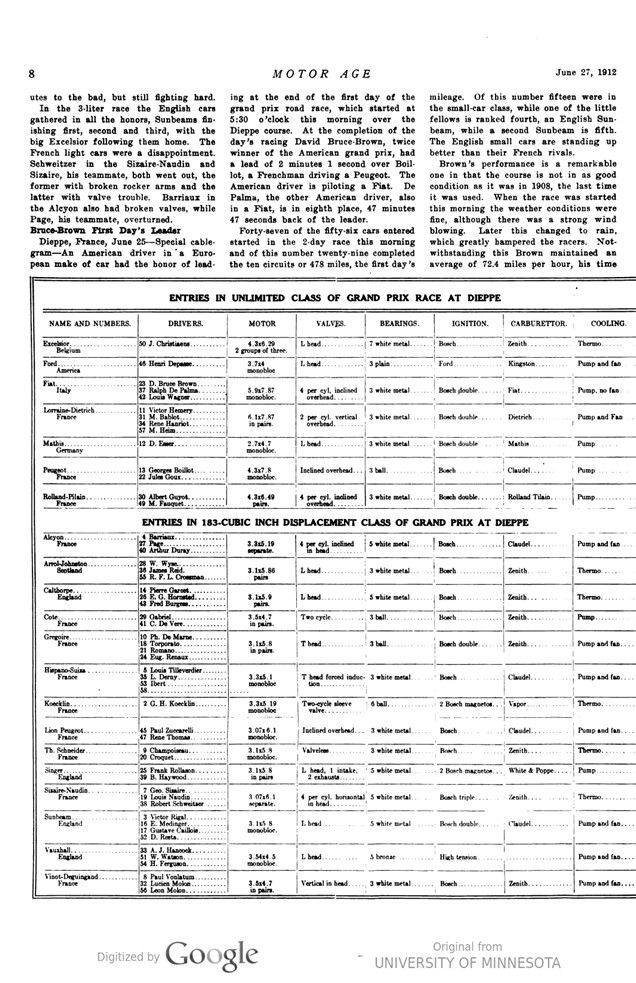
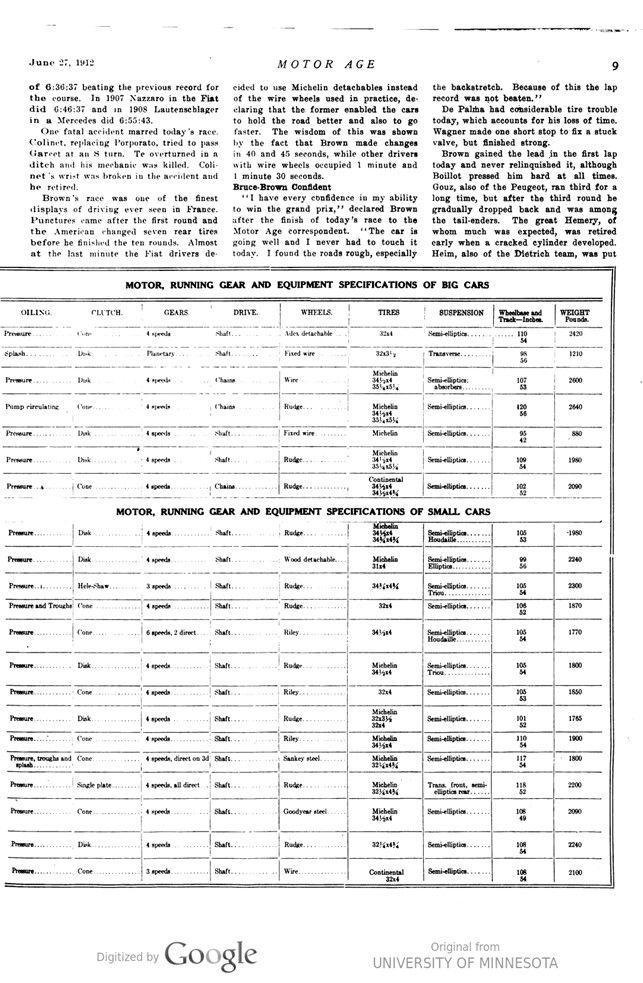
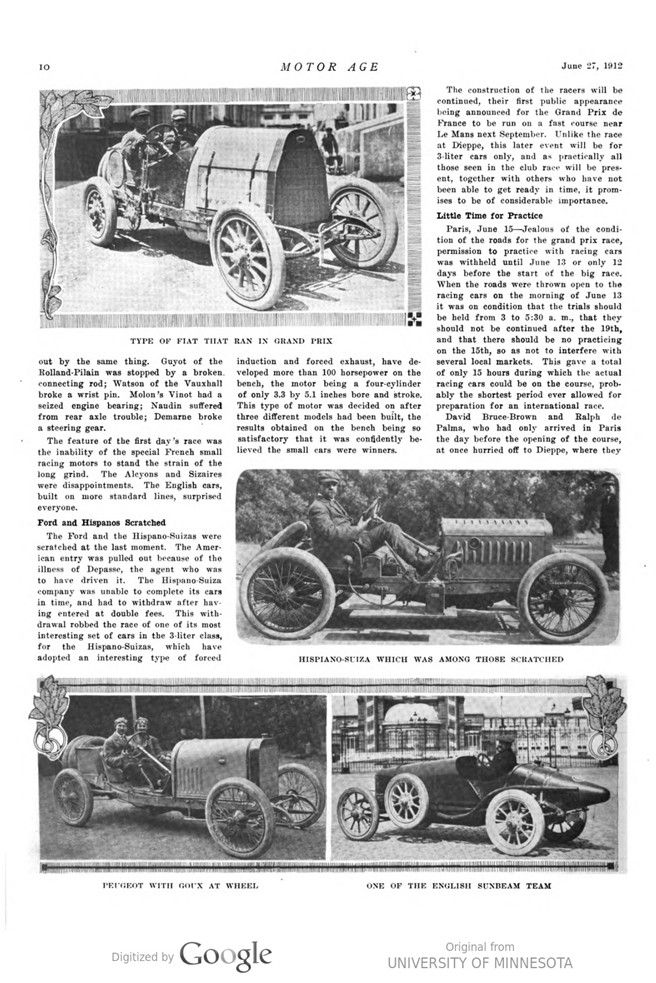
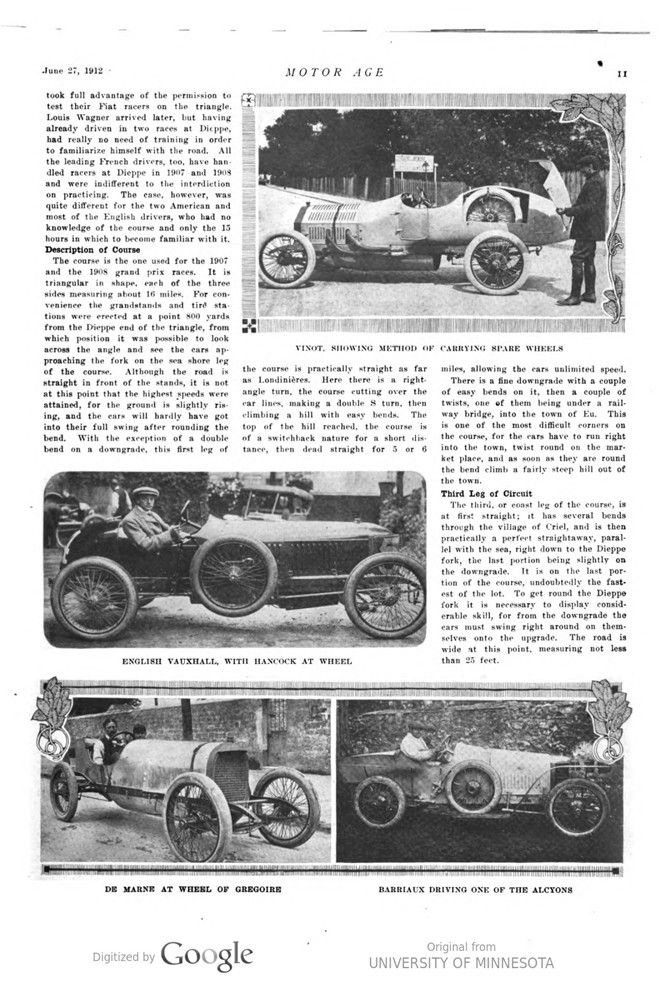
Text and jpegs by courtesy of hathitrust.org www.hathitrust.org, compiled by motorracinghistory.com
MOTOR AGE Vol. XXI, No. 26, June 27, 1912
Boillot, Peugeot, Grand Prix Winner
Wagner, Fiat, Second – Bruce-Brown Leader at End of First Day – Small-Car Division Won by Sunbeam
By W. F. Bradley
DIEPPPE, France, June 26 – Special cablegram – The French grand prix, an international road race run over a distance of 956 miles – 478 miles per day – yesterday and today was won by Boillot in a Peugeot, with Wagner in a Fiat second, Rigal in an English Sunbeam third and Resta, also in a Sunbeam, fourth. While all one race, the field was divided into two classes, one unlimited and the other for cars of 183 cubic inches displacement and a minimum weight of 1,763 pounds, empty. In the latter division the winner was Rigal in a Sunbeam.
The result must be very disappointing to Americans, for when the first day’s racing was concluded David Bruce-Brown in a Fiat was leading Boillot, the ultimate winner, by 2 minutes, while de Palma, the other American, was eighth. Both Brown and de Palma, however, along with Goux, Frenchman, were disqualified for taking on fuel away from the pits. Brown the first day averaged 72.4 miles per hour over a heavy course, breaking the race record, while today, in the last half of the race this average was materially lower, Boillot only doing 65.3 miles per hour. He made 72.2 yesterday, which makes his general average for the 2 days 68.7 miles per hour. 67.5 miles Wagner’s 2-day average was per hour; Rigal’s 65 and Resta’s 64.8.
Of the original field of fifty-six nominated ten were scratched, among the withdrawals being the Ford, which was pulled out because of the illness of its driver, Henry Depasse.
The second day opened with the skies lowering and with rain threatening; in fact, when the first car got away it was raining, but by the time the last racer got under way it had stopped and fine weather prevailed. But the rain had spoiled all chances of the record being broken, for the roads were rather heavy and the course was cut up on the turns.
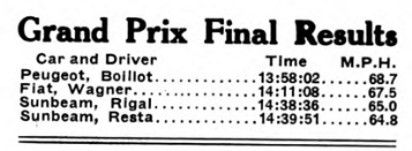
Twenty-two cars started this morning, but before the start it was announced that Goux and de Palma had been dis- qualified because of the rule that declares all supplies must be taken on at the pits. Both de Palma and Goux were forced to take on gasoline when they fractured their fuel lines on the road. When this became known the committee in charge of the race promptly disqualified them.
The Gregoires were withdrawn because of yesterday’s accident, which resulted in the death of a mechanic. There was plenty of excitement attending the start. Hanriot’s car caught fire running to the official garage and he, too, was out of the running. This reduced the field to twenty-two starters. The first cars were hauled out of the garage by hand, the drivers being forbidden to touch them until starting time. Bruce-Brown made a quick get-away, then drove to his pit where he took on gasoline and changed tires. He was the first to get under way and disappeared from view while the others were struggling at the pit. Boillot, runner-up yesterday and today’s winner, had great difficulty in starting his motor. He lost 9 minutes at the pits and Resta and Wagner had left before he was ready. Rigal, second in the light-car section, also had trouble with a cold motor, while Duray, unable to start, pushed his car down the road to his pit where he could work on it to greater advantage. Tauquet, driving a Rolland-Pilain under the name of Anford, experienced the greatest difficulty in starting his motor. He worked three-quarters of an hour, when so exhausted he turned his car over to Guyot, who quickly got away with it. Every car stopped at the pits for supplies before actually starting in he was the race.
The feature of the day’s race was the struggle between Bruce-Brown and Boil- lot before the former was disqualified. The American had the advantage by about 2 minutes at the end of yesterday’s race, and he increased this by his quick get-away today and because of Boillot’s trouble in starting his motor. But the American soon ran into tire troubles, of which Boillot had none, and the Frenchman, by opening his throttle and speeding up, cut down the gap to about 6 minutes, the time at the end of the first round being Brown, 7:24:24; Boillot, 7:30:58. Wagner was 19 minutes behind the Peugeot driver, while back of him was Rigal, fourth. The latter, however, was leading in the light-car division and seemed likely to stay there.
Brown still held his lead at the end of the twelfth round of the race and the second of today’s half, but his advantage had been cut down to 82 seconds, Boillot still running all out. During the thirteenth round Boillot gained still more, only 11 seconds separating him from the American. The Brown Fiat, being heavier than Peugeot, suffered more from tire trouble, but not counting that, the Peugeot developed speed it did not seem to have yesterday.
In the thirteenth round Boillot crept closer and closer to Brown and as the two passed the tape entering the fourteenth lap it was seen that Brown only had about 100 yards‘ lead over his grim pursuer. A few miles further on Boillot actually caught and passed Brown and for the first time was in front. Then came the American’s great misfortune. He did not pass Eu and when Wagner, who had been left far in the rear, passed the pits he reported his teammate on the shore leg.
Finally, up from the Dieppe fork came the American and it was evident that something had happened. He was running slowly, but as he reached the pit, he did not stop his motor. A few words explained that his gasoline supply had run out and he had been obliged to take on fuel along the course. This meant disqualification without a doubt in view of what happened to Goux and de Palma. Brown talked it over with the Fiat team manager and then concluded to finish the race, although his time no longer was taken.
This sporty decision to continue, although he would receive no official recognition, gave Brown considerable prestige and undoubtedly added to the interest in the race. With him out of the way the race became a struggle between Boillot in the Peugeot and Wagner in the Fiat, but although the Fiat was faster than the French car, Wagner gained only slowly, considering the second day as an independent race. He was unable to wipe out Boillot’s lead of yesterday, and even though he was first to finish today’s race after starting third, he still was 13 minutes to the bad, but still fighting hard.
In the 3-liter race the English cars gathered in all the honors, Sunbeams finishing first, second and third, with the big Excelsior following them home. The French light cars were a disappointment. Schweitzer in the Sizaire-Naudin and Sizaire, his teammate, both went out, the former with broken rocker arms and the latter with valve trouble. Barriaux in the Alcyon also had broken valves, while Page, his teammate, overturned.
Bruce-Brown First Day’s Leader
Dieppe, France, June 25-Special cablegram – An American driver in a European make of car had the honor of leading at the end of the first day of the grand prix road race, which started at 5:30 o’clock this morning over the Dieppe course. At the completion of the day’s racing David Bruce-Brown, twice winner of the American grand prix, had a lead of 2 minutes 1 second over Boillot, a Frenchman driving a Peugeot. The American driver is piloting a Fiat. De Palma, the other American driver, also in a Fiat, is in eighth place, 47 minutes 47 seconds back of the leader.
Forty-seven of the fifty-six cars entered started in the 2-day race this morning and of this number twenty-nine completed the ten circuits or 478 miles, the first day’s mileage. Of this number fifteen were in the small-car class, while one of the little fellows is ranked fourth, an English Sunbeam, while a second Sunbeam is fifth. The English small cars are standing up better than their French rivals.
Brown’s performance is a remarkable one in that the course is not in as good condition as it was in 1908, the last time it was used. When the race was started this morning the weather conditions were fine, although there was a strong wind blowing. Later this changed to rain, which greatly hampered the racers. Notwithstanding this Brown maintained an average of 72.4 miles per hour, his time of 6:36:37 beating the previous record for the course. In 1907 Nazzaro in the Fiat did 6:46:37 and in 1908 Lautenschlager in a Mercedes did 6:55:43.
One fatal accident marred today’s race. Colinet, replacing Porporato, tried to pass Garcet at an S turn. He overturned in a ditch and his mechanic was killed. Colinet’s wrist was broken in the accident and be retired.
Brown’s race was one of the finest displays of driving ever seen in France. Punctures came after the first round and the American changed seven rear tires before he finished the ten rounds. Almost at the last minute the Fiat drivers decided to use Michelin detachables instead of the wire wheels used in practice, declaring that the former enabled the cars to hold the road better and also to go faster. The wisdom of this was shown by the fact that Brown made changes in 40 and 45 seconds, while other drivers with wire wheels occupied 1 minute and 1 minute 30 seconds.
Bruce Brown Confident
„I have every confidence in my ability to win the grand prix,“ declared Brown after the finish of today’s race to the Motor Age correspondent. The car is going well and I never had to touch it today. I found the roads rough, especially the backstretch. Because of this the lap record was not beaten.“
De Palma had considerable tire trouble today, which accounts for his loss of time. Wagner made one short stop to fix a stuck valve but finished strong.
Brown gained the lead in the first lap today and never relinquished it, although Boillot pressed him hard at all times. Gouz, also of the Peugeot, ran third for a long time, but after the third round he gradually dropped back and was among the tailenders. The great Hemery, of whom much was expected, was retired early when a cracked cylinder developed. Heim, also of the Dietrich team, was put out by the same thing. Guyot of the Rolland-Pilain was stopped by a broken connecting rod; Watson of the Vauxhall broke a wrist pin. Molon’s Vinot had a seized engine bearing; Naudin suffered from rear axle trouble; Demarne broke a steering gear.
The feature of the first day’s race was the inability of the special French small racing motors to stand the strain of the long grind. The Alcyons and Sizaire’s were disappointments. The English cars, built on more standard lines, surprised everyone.
Ford and Hispanos Scratched
The Ford and the Hispano-Suiza’s were scratched at the last moment. The American entry was pulled out because of the illness of Depasse, the agent who was to have driven it. The Hispano-Suiza company was unable to complete its cars in time and had to withdraw after having entered at double fees. This withdrawal robbed the race of one of its most interesting set of cars in the 3-liter class, for the Hispano-Suiza’s, which have adopted an interesting type of forced induction and forced exhaust, have developed more than 100 horsepower on the bench, the motor being a four-cylinder of only 3.3 by 5.1 inches bore and stroke. This type of motor was decided on after three different models had been built, the results obtained on the bench being so satisfactory that it was confidently believed the small cars were winners.
The construction of the racers will be continued, their first public appearance being announced for the Grand Prix de France to be run on a fast course near Le Mans next September. Unlike the race at Dieppe, this later event will be for 3-liter cars only, and as practically all those seen in the club race will be present, together with others who have not been able to get ready in time, it promises to be of considerable importance.
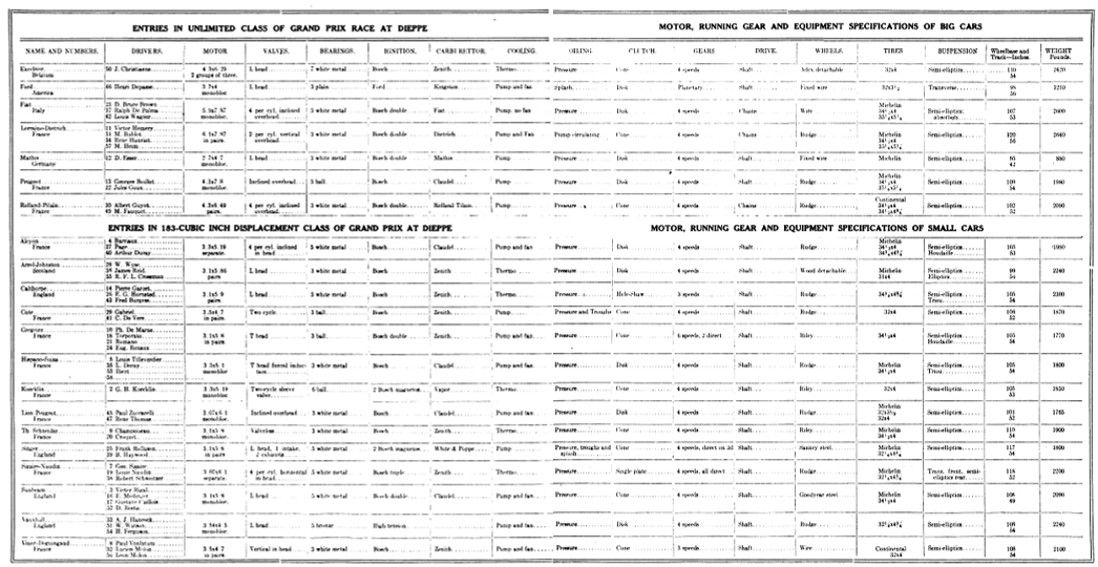
ENTRIES IN 183-CUBIC INCH DISPLACEMENT CLASS OF GRAND PRIX AT DIEPPE – MOTOR, RUNNING GEAR AND EQUIPMENT SPECIFICATIONS OF SMALL CARS
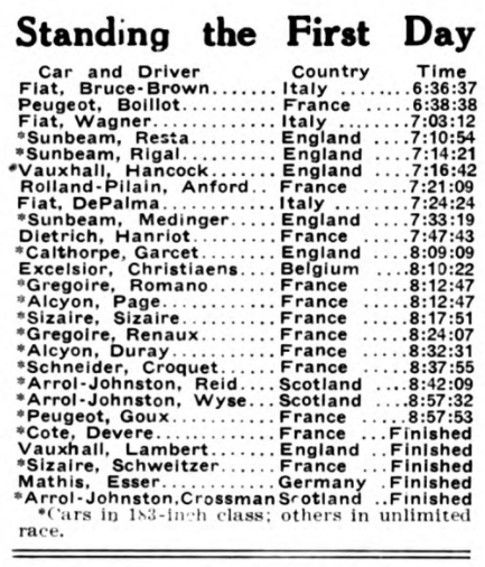
Little Time for Practice
Paris, June 15 – Jealous of the condition of the roads for the grand prix race, permission to practice with racing cars was withheld until June 13 or only 12 days before the start of the big race. When the roads were thrown open to the racing cars on the morning of June 13 it was on condition that the trials should be held from 3 to 5:30 a.m., that they should not be continued after the 19th, and that there should be no practicing on the 15th, so as not to interfere with several local markets. This gave a total of only 15 hours during which the actual racing cars could be on the course, probably the shortest period ever allowed for preparation for an international race.
David Bruce-Brown and Ralph de Palma, who had only arrived in Paris the day before the opening of the course, at once hurried off to Dieppe, where they took full advantage of the permission to test their Fiat racers on the triangle. Louis Wagner arrived later, but having already driven in two races at Dieppe, had really no need of training in order to familiarize himself with the road. All the leading French drivers, too, have handled racers at Dieppe in 1907 and 1908 and were indifferent to the interdiction on practicing. The case, however, was quite different for the two American and most of the English drivers, who had no knowledge of the course and only the 15 hours in which to become familiar with it.
Description of Course
The course is the one used for the 1907 and the 1908 grand prix races. It is triangular in shape, each of the three sides measuring about 16 miles. For convenience the grandstands and tire stations were erected at a point 800 yards from the Dieppe end of the triangle, from which position it was possible to look across the angle and see the cars approaching the fork on the seashore leg of the course. Although the road is straight in front of the stands, it is not at this point that the highest speeds were attained, for the ground is slightly rising, and the cars will hardly have got into their full swing after rounding the bend. With the exception of a double bend on a downgrade, this first leg of the course is practically straight as far as Londinières. Here there is a right-angle turn, the course cutting over the ear lines, making a double S turn, then climbing a hill with easy bends. The top of the hill reached, the course is of a switchback nature for a short distance, then dead straight for 5 or 6 miles, allowing the cars unlimited speed. There is a fine downgrade with a couple of easy bends on it, then a couple of twists, one of them being under a railway bridge, into the town of Eu. This is one of the most difficult corners on the course, for the cars have to run right into the town, twist round on the market place, and as soon as they are round the bend climb a fairly steep hill out of the town.
Third Leg of Circuit
The third, or coast leg of the course, is at first straight; it has several bends through the village of Criel, and is then practically a perfect straightaway, parallel with the sea, right down to the Dieppe fork, the last portion being slightly on the downgrade. It is on the last portion of the course, undoubtedly the fastest of the lot. To get round the Dieppe fork it is necessary to display considerable skill, for from the downgrade the cars must swing right around on them- selves onto the upgrade. The road is wide at this point, measuring not less than 25 feet.
photo captions.
Page 5.
GRAND PRIX DE L’A.C.F. – CIRCUIT DE DIEPPE Coupe de L’AUTO 25-26 JUIN
BOILLOT – HEMERY – DE PALMA – DURAY – BROWN – NAUDIN – CAILLOIS – DERNEY
Page 6.
PITS IN FRONT OF GRAND PRIX GRANDSTAND – FINE STRAIGHTAWAY ON DIEPPE COURSE
PICTURESQUE BRIDGE AT EU ON DIEPPE COURSE (Continue L’HERMEROUTH)
Standing the First Day
Page 7.
AS THE GRANDSTANDS LOOKED PARTIALLY COMPLETED – GAILLARD, AUTOMOBILES HOTCHKISS
SHARP TURN ON COURSE AT LONDINIERES – DIEPPE FORKS, GRANDSTAND BEYOND BROW OF HILL
Page 8.
ENTRIES IN UNLIMITED CLASS OF GRAND PRIX RACE AT DIEPPE – MOTOR, RUNNING GEAR AND EQUIPMENT SPECIFICATIONS OF BIG CARS
ENTRIES IN 183-CUBIC INCH DISPLACEMENT CLASS OF GRAND PRIX AT DIEPPE – MOTOR, RUNNING GEAR AND EQUIPMENT SPECIFICATIONS OF SMALL CARS
NAME AND NUMBERS. – DRIVERS. – MOTOR. – VALVES. – BEARINGS. – IGNITION. – CARBURETTOR. – COOLING. – OILING. – CLUTCH. – GEARS. – DRIVE. – WHEELS. – TIRES. – SUSPENSION. – WEIGHT.
Page 10.
TYPE OF FIAT THAT RAN IN GRAND PRIX – HISPIANO-SUIZA WHICH WAS AMONG THOSE SCRATCHED
WITH GOUX AT WHEEL ONE OF THE ENGLISH SUNBEAM TEAM
Page 11.
VINOT, SHOWING METHOD OF CARRYING SPARE WHEELS – ENGLISH VAUXHALL, WITH HANCOCK AT WHEEL
DE MARNE AT WHEEL OF GREGOIRE – BARRIAUX DRIVING ONE OF THE ALCYONS

